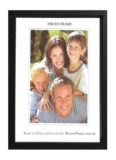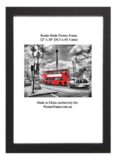Ever since the first picture frame was , probably around 2.500 years ago the image's artist and owner must have wrestled with the portrait vs landscape or ientation compositional conundrum, should it be framed portrait or landscape? Which would look better? And of course, we are not referring to art photography where ‘portrait’ main mean portraiture by photography and ‘landscape” may mean nature or outdoor photography. In picture framing, portrait means when someone frames and hangs the picture vertically, or longways, whereas landscape means when someone one frames and hangs a picture horizontally, or sideways. To put it in another way, the portrait format means that an image is taller than it is wide and landscape means that it is wider than... it is tall. Naturally, before and image is picture framed, one has to create and capture it, and in many case this is done via photography. But wait, before even the very first photographers, there were painters, master painters who painted canvases, such as Leonardo Da Vinci. And Lenny boy painted the world as he saw it.
ientation compositional conundrum, should it be framed portrait or landscape? Which would look better? And of course, we are not referring to art photography where ‘portrait’ main mean portraiture by photography and ‘landscape” may mean nature or outdoor photography. In picture framing, portrait means when someone frames and hangs the picture vertically, or longways, whereas landscape means when someone one frames and hangs a picture horizontally, or sideways. To put it in another way, the portrait format means that an image is taller than it is wide and landscape means that it is wider than... it is tall. Naturally, before and image is picture framed, one has to create and capture it, and in many case this is done via photography. But wait, before even the very first photographers, there were painters, master painters who painted canvases, such as Leonardo Da Vinci. And Lenny boy painted the world as he saw it.
One fine day in the 16th century he visualised the gathering of The Last Supper gathering as a landscape, and he rendered it thus. Some years later he met up with Mona Lisa and he painted her portrait. We hazard to guess that like the long-deceased Italian master painter, our natural tendency is to draw, compose, paint or shoot our subjects as we see them.
If they’re mostly tall we tend to do portrait, if they’re mostly wide we tend to do landscape. But it is at this point that the wonderings with questions arise, is one of the two better than the other? Fortunately there are norms or models to help one chose. Perhaps the best known is that of when photographing people not very near or close by.
We often photograph choosing the vertical, or portrait orientation, because we are bipedal primates and stand or sit upright. Subconsciously, a vertical object is a symbol of strength, power, authority, virility and dominance. A powerful victor invariably stands erect and vertical over his weak, vanquished and prostrated foe. This conveys, connotes and implies a vertical format, therefore a complimenting structural composition is almost de riguer.
The converse is true of horizontal subjects, situations or panoramas. Witness the sky, the sea, lakes, mountains, rivers, hills or meadows, to name but a few. All of these beg for landscape, or horizontal compositions, it’s the nature of the beast, so to speak. There also many photographic subject with in-built leading lines which strongly favour a landscape take.

These include walls, roads, fields, bridges, dams, paths and many, antique and historical buildings. Indeed just about every image and photograph found online of the Taj Mahal is not portrait, but landscape.
Another useful aspect of the landscape aspect is that it tends to emphasize is that it tends to emphasize space and surroundings vis~a~ vis the subject matter. Of course, the choice will also depend on the desire of the photographer on expressing his creativity.
For instance, if the subject matter is the famous Statue of Liberty in New York, a portrait shot close tends to emphasize the statue’s size, permanence and solidity. On the other hand a far away still of the of the statue, may presents an entire disparate suggestion, perhaps that of the statue being a sentinel, guarding America, or the deliverer of a message of hope. Whatever the interpretation, it is clear that a change of orientation often alters the mood, feeling and message of the art.
And while the following goes beyond the portrait-or-landscape topic at hand, budding photographers, could find photography’s “Rule of Thirds” helpful in assessing the choice of orientation. Let us refer to the composition below:

The photographer has avoided many a photography’s novice’s error by avoiding to centre the horizon in the middle of the image. The picture had been thus been visually divided in 3 imaginary rows, or more appealing, thirds.
The top is the sky, the middle is the sea and the bottom is the land. In fact this concept has been known for so long that some photographic cameras even have this rule etched in their viewfinders:

Again, they say that rules are made to be broken, so feel free to liberate yourself from these should you wish to try and compose something different or with an unusual ‘slant”.
There are also other practical reasons as to why one orientation can be more advantageous then the other. Landscape photographs can often be cropped or trimmed to become portrait, because there may so much negative space at the sides of the subject, but the reverse is often difficult to do because we can’t add what isn’t there.
Yet another interesting aspect of the portrait vs landscape orientation selection is that in media articles at least, landscape images work better than portrait one. Our vision is also naturally wider than it is higher. It is binocular, with a pair of eyes that are next to one another, not on top of each other. Our natural proclivity is to scan sideways, rather than up and down, because our eyes are positioned horizontally, thus naturally endowing us a with a horizontal or landscape view.
This fortunate evolutionary development allows us to be see more peripherally, taking more, visually speaking.Cameras have long been built to reflect this and most, if not all, bodies and viewfinders are landscape, not portrait. With regard to picture frames and picture framing the portrait-vs-landscape conundrum is easier. Generally when picture framers receive a photo, picture or image, it is already formatted and the Customer has already decided the orientation.
Occasionally though, if the subject at hand displays a preponderance of negative space, the art’s orientation can easily by changed by appropriate cropping. We have done this ourselves a few times.Generally we place some matboard strips on all four sides of the art and prepare both portrait and landscape masks for the Customer to decide. In picture framing, another not very well known tip is that picture framers can tell by how a size is stated, given or requested which way a picture should orientate.
So if it’s 50x70cms we know it’s going to be portrait ( narrowest side at the top and bottom ) and if its instead given as s70x50cms it will be landscape (widest size at the top and bottom ). Lastly, to make a custom picture frame portrait, landscape or square is easy. All we need to do is measure, cut, join and cord the frame according to the mounted art. Ready-Made frames are even easier. By default these come with both portrait and landscape orientation hangers, no need to change or modify anything! Thank you for reading this post " The Great and Enduring Picture Framing Controversy on Portrait vs Landscape Orientation".









I have a lot of gratitude for this news blog. This is a great place for reading over expert picture framing trade secrets. This website is highly regarded, very respected and will advance me in my studies and hobbies. I saved this web news blog and will be returning for related posts and articles. I discovered the information for window mats that I had already hunted all over the place and just couldn’t come across. What an informative forum!